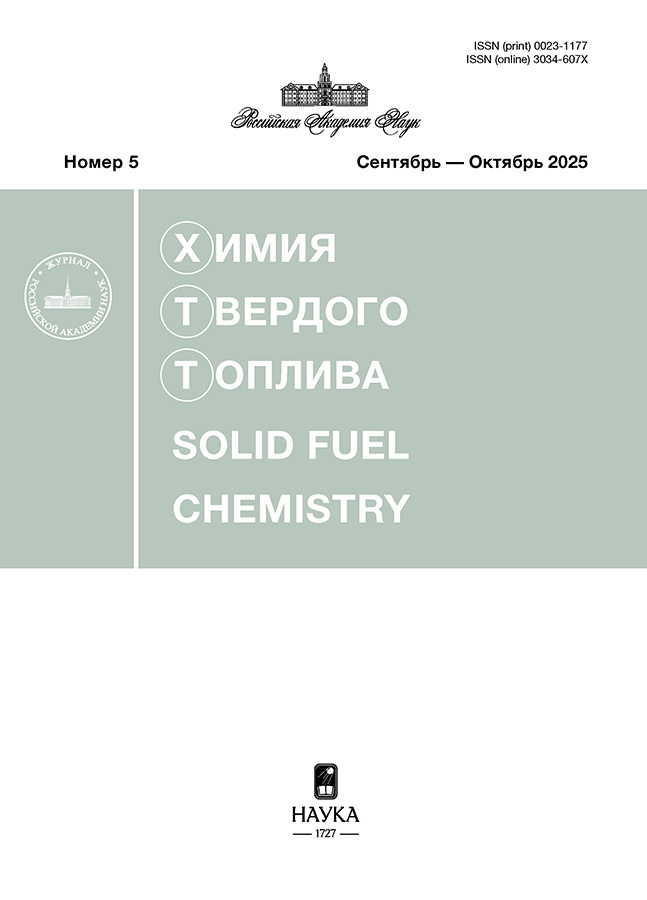Коллоидно-дисперсные свойства нефтяных эмульсий в электромагнитном поле
- Авторы: Лоскутова Ю.В.1, Юдина Н.В.1
-
Учреждения:
- ФГБУН Институт химии нефти СО РАН
- Выпуск: № 1 (2025)
- Страницы: 26-32
- Раздел: Статьи
- URL: https://kazanmedjournal.ru/0023-1177/article/view/684043
- DOI: https://doi.org/10.31857/S0023117725010047
- EDN: https://elibrary.ru/KUTKRM
- ID: 684043
Цитировать
Полный текст
Аннотация
Изучено влияние электромагнитного поля на коллоидно-дисперсные свойства водонефтяных эмульсий двух смолистых малопарафинистых нефтей. Показано, что максимальный результат расслоения водонефтяных эмульсий достигается после 15 минут обработки для 10 мас. % эмульсий – на частоте 250 Гц и напряжении 17 кВ; для 30 мас. % – 500 Гц и 15 кВ соответственно. С увеличением времени обработки эмульсий происходит уменьшение размера и количества капель в нефтяной фазе, а остаточная обводненность обработанных эмульсий после расслоения не превышает 0.5 мас. %. В электромагнитном поле процесс коалесценции капля–капля в эмульсии усиливаются из-за разрушения бронирующих оболочек глобул воды, образования новых смолисто-асфальтеновых агрегатов большего или меньшего размера и перераспределения компонентов между дисперсионной средой и дисперсной фазой.
Ключевые слова
Полный текст
Об авторах
Ю. В. Лоскутова
ФГБУН Институт химии нефти СО РАН
Автор, ответственный за переписку.
Email: reoloil@ipc.tsc.ru
Россия, 634055 Томск
Н. В. Юдина
ФГБУН Институт химии нефти СО РАН
Email: natal@ipc.tsc.ru
Россия, 634055 Томск
Список литературы
- Sjoblom J., Aske N., Auflem I.H., Brandal O., Havre T.E., Sather O., Kallevik H. // Adv. Colloid Interface Sci. 2003. V. 100. P. 399–473. https://doi.org/10.1016/S0001-8686(02)00066-0
- Волкова Г.И., Лоскутова Ю.В., Прозорова И.В., Березина Е.М. Подготовка и транспорт проблемных нефтей. Томск: Изд-во ТГУ, 2015. 136 с.
- Langevin D., Poteau S., Hénaut I., Argillier J.F. // Oil & Gas Science and Technology – Rev. IFP. 2004. V. 59. № 5. P. 511-521. https://doi.org/10.2516/ogst:2004036
- Crude Oil Emulsions – Composition Stability and Characterization. Edited by Manar El-Sayed Abdel-Raouf. INTECH, 2012. 230 p. www. intechopen.org.
- Djuve J., Yang X., Fjellanger I.J., Sjoblom J., Pelizzetti E. // Colloid Polym. Sci. 2001. V. 279. № 3. P. 232–239. https://doi.org/10.1007/s003960000413
- Тронов В.П. Промысловая подготовка нефти. Казань: Изд-во “Фэн”, 2000. 260 с.
- Taolti S., Yiyang Z., Lu W., Sui Z., Bo P., Li M., Yu J. //J. Colloid Interfact Science. 2002. V. 255. P. 241–247. 10.1006/jcis.2002.8661' target='_blank'>https://doi: 10.1006/jcis.2002.8661
- Alsabagh A.M., Hassan M.E., Desouky S.E.M., Nasser N.M., Elsharaky E.A., Abdelhamid M.M. // Egyptian Journal of Petroleum. 2016. V. 25. № 4. P. 585–595. https://doi.org/10.1016/j.ejpe.2016.05.008
- Delfos R., Murphy S., Stanbridge D., Olujić Ž., Jansens P.J. // Minerals Engineering. 2004. V. 17. № 5. P. 721–731. https://doi.org/10.1016/j.mineng.2004.01.012
- Ni X., Mignard D., Saye B., Johnstone J.C., Pereira N. // Chemical Engineering Science. 2002. V. 57. № 11. P. 2101–2114. https://doi.org/10.1016/S0009-2509(02)00100-8
- Zhao F., Tian Z., Yu Z., Shang H., Wu Y., Zhang Y. // Energy Sci Eng. 2020. V. 8. P. 4158–4175. https://doi.org/10.1002/ese3.814
- Sjöblom J., Mhatre S., Simon S., Skartlien R., Sørland G. // Advances in Colloid and Interface Science. 2021. V. 294. P. 102455. https://doi.org/10.1016/j.cis.2021.102455
- Yang D., Xu M., He L., Luo X., Lü Y., Yan H., Tian C. // Chemical Engineering Science. 2015. V. 138. P. 71–85. https://doi.org/10.1016/j.ces.2015.07.049
- Loskutova Yu.V., Yudina N.V. // Petroleum Chemistry. 2022. V. 62. № 5. P. 506–514. https://doi.org/10.1134/S0965544122020220
- Kovaleva L.A., Minnigalimov R.Z., Zinnatullin R.R. // Energy&Fuels. 2011. V. 25. P. 3731–3738. https://doi.org/10.1021/ef200249a
- Hosseini M., Shahavi M.H. // Separation Science and Engineering. Chinese Journal of Chemical Engineering. 2012. V. 20. № 4. P. 654–658.
- Eowa J.S., Ghadiri M., Sharif A.O., Williams T.J. // Chemical Engineering Journal. 2001. V. 84. P. 173–192. https://doi.org/10.1016/S1385-8947(00)00386-7
- Taghavi H., Ashoori S., Mousavi S.H. // Petroleum Science and Technology. 2017. V. 36. № 7. P. 1–7. http://dx.doi.org/10.1080/10916466.2017.1347680
- Ali N., Zhang B., Zhang H., Zaman W., Li X., Li W., Zhang Q. // Colloids and Surfaces A: Physicochem. Eng. Aspects. 2015. V. 472. P. 38–49. https://dx.doi.org/10.1016/j.colsurfa.2015.01.087
- Yang D., Ghadiri M., Sun Y., He L., Luo X., Lü Y. // Chemical Engineering Research and Design. 2018. V. 136. P. 83–93. https://doi.org/10.1016/j.cherd.2018.05.004
- Less S., Vilagines R. // Journal of Petroleum Science and Engineering. 2012. V. 81. P. 57–63. https://dx.doi.org/10.1016/j.petrol.2011.12.003
- Mhatre S., Thaokar R. // Chemical Engineering and Processing. 2015. V. 96. P. 28–38. http://dx.doi.org/10.1016/j.cep.2015.07.025
Дополнительные файлы












